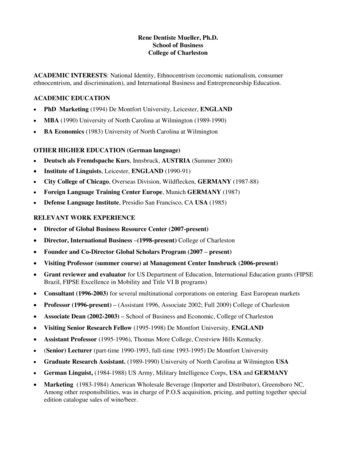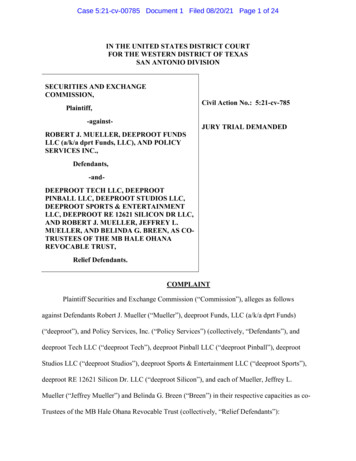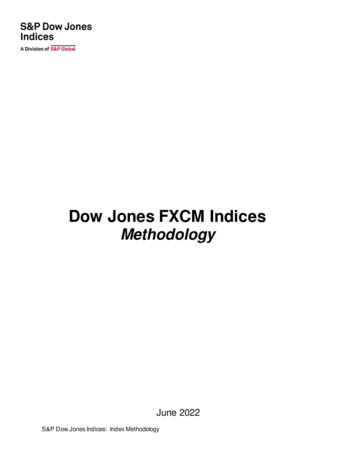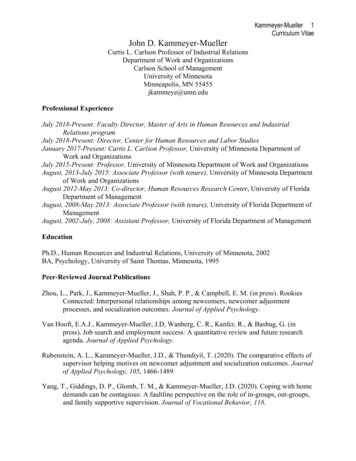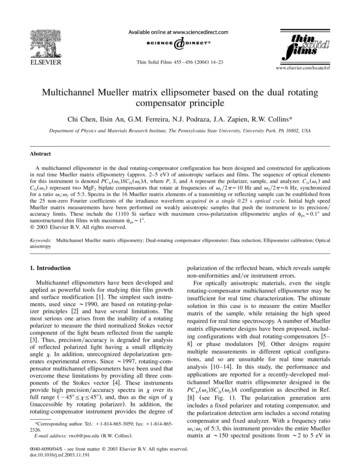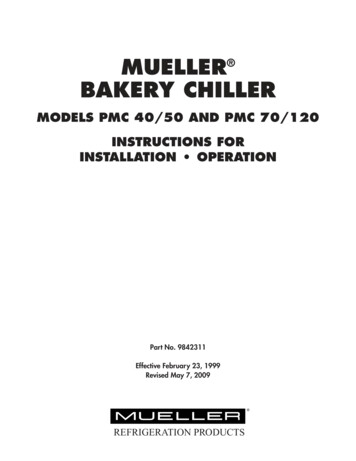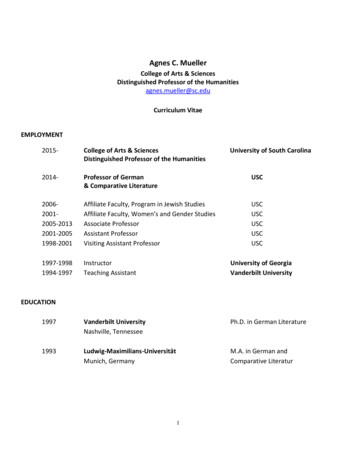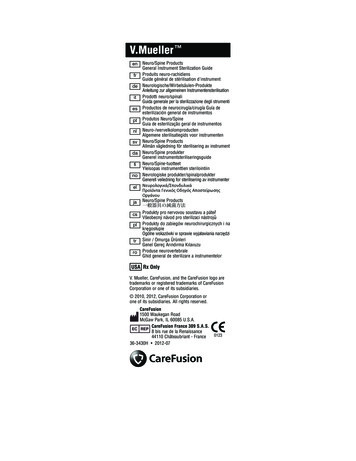
Transcription
17. Jones Matrices & Mueller MatricesJones MatricesRotation of coordinates - the rotation matrixStokes Parameters and unpolarized lightMueller MatricesSir George G. Stokes(1819 - 1903)R. Clark Jones(1916 - 2004)Hans Mueller(1900 - 1965)
Jones vectors describe the polarizationstate of a waveDefine the polarization state of a field as a 2D vector—“Jones vector” —containing the two complex amplitudes: Ex 1 E Ex Ey E y Ex 1Ex E y22 Ex E y (normalized to length of unity) 1 0 A few examples:0 linear (x) polarization: Ey /Ex 0linear (arbitrary angle) polarization: Ey /Ex tan right or left circular polarization: Ey /Ex j 1 tan 1 j
To model the effect of a medium on light'spolarization state, we use Jones matrices.Since we can write a polarization state as a (Jones) vector, we usematrices, A, to transform them from the input polarization, E0, to theoutput polarization, E1. a11A a21E1 AE0This yields:This should bethought of as atransfer function.E1x a11 E0 x a12 E0 yE1 y a21 E0 x a22 E0 yFor example, an x-polarizer can be written:So:a12 a22 1 0 Ax 00 1 0 E0 x E0 x E1 A x E0 E 0 0 0 y 0
Other Jones matricesA y-polarizer:A half-wave plate: 0 0 Ay 01 A HWP 1 0 01 A half-wave plate rotates 45-degreepolarization to -45-degree, and vice versa.A quarter-wave plate:A QWP 1 0 0 j R. Clark Jones(1916 - 2004) 1 0 1 1 0 1 1 1 1 0 1 1 0 1 1 1 1 0 1 1 0 j 1 j
The orientation of a wave platematters.0 or 90 PolarizerRemember that a quarter-wave plateonly converts linear to circular if theinput polarization is 45 .If it sees, say, x polarization,the input is unchanged.Wave platew/ axes at0 or 90 1 0 1 1 0 j 0 0 AQWPJones matrices are an extremely useful way to keep track of all this.
A wave plate exampleWhat does a quarter-wave plate do if the input polarization is linearbut at an arbitrary angle?1 1 0 1 0 j tan j tan AQWPEinEoutFor arbitrary , this is an elliptical polarization. 30 45 60
Jones Matrices for standard components
Rotated Jones matricesWhat about when the polarizer or wave plate responsible forthe transfer function A is rotated by some angle, ?Rotation of a vector by an angle means multiply by the rotation matrix:rotated Jones vectorof the inputwhere:E0 ' R E0andE1 ' R E1rotated Jones vectorof the output cos( ) sin( ) R sin( ) cos( ) Rotating E1 by and inserting the identity matrix R( )-1 R( ), we have: 1E1 ' R E1 R AE0 R A R R E0 1 1 R AR R E0 R AR E0 ' A ' E0 ' Thus:A ' R AR 1
Rotated Jones matrix for a polarizerExample: apply this to an x polarizer. A ' R A R 1 cos( ) sin( ) 1 0 cos( ) sin( ) Ax 0 0 sin( ) cos( ) sin()cos() cos( ) sin( ) cos( ) sin( ) 0 sin( )cos( )0 cos 2 ( )cos( ) sin( ) 2sin ( ) cos( ) sin( )So, for example: 1/ 2 1/ 2 Ax 45 1/21/2 1 Ax 0 for a smallangle
To model the effect of many media on light'spolarization state, we use many Jones matrices.The aggregate effect of multiple components or objects can bedescribed by the product of the Jones matrix for each one.input E0transfer function A1A2A3output E1E1 A 3 A 2 A1 E0The order may look counter-intuitive, but order matters!
xMultiplying Jones MatricesyCrossed polarizers:E0E1 A y A x E0x-polE1y-pol 0 0 1 0 0 0 Ay Ax 010000 rotatedx-polUncrossed polarizers(by a slight angle ):E0 0 0 1 0A y A x 0 1 0 Ex 0A y A x E y so no light leaks through.E10 0 0 Ex 0 0 E y Ex y-polSo Iout 2 Iin,xz
xMultiplying Jones MatricesyNow, it is easy to compute howinserting a third polarizerbetween two crossed polarizersleads to larger transmission.E0x-polE145º-poly-polE1 A y A 45 A x E0 1 0 0 2A y A 45 A x 101 2Thus:z1 0 0 2 1 0 1 01 0 0 2 2 0 0 Ex ,in 0 E1 1 1 2 0 E y ,in Ex ,in 2 The third polarizer, between the other two, makes thetransmitted wave non-zero.
Natural light (e.g., sunlight, light bulbs, etc.)is unpolarizedThe direction of the E vector israndomly changing. But, it isalways perpendicular to thepropagation direction.polarized lightnatural light
Light with very complex polarizationvs. position is "unpolarized."Light that has scattered multiple times, or that has scatteredrandomly, often becomes unpolarized as a result.Here, light from the blue sky ispolarized, so when viewedthrough a polarizer it looksmuch darker. Light from cloudsis unpolarized, so its intensity isreduced by only 50%.If the polarization vs. position is unresolvable, we call this“unpolarized.” Otherwise, we refer to this light as “locallypolarized” or “partially polarized.”
When the phases of the x- and y-polarizationsfluctuate, we say the light is "unpolarized." E ( z , t ) Re E t Ex ( z , t ) Re E0 x exp j kz t x t y0yexp j kz t ywhere x(t) and y(t) are functions that vary on a time scale slower thanthe period of the wave, but faster than you can measure.The polarization state (Jones vector) is:1 E 0 y exp j t j t x y E0 x In practice, theamplitudes are alsofunctions of time!As long as the time-varying relative phase, x(t)– y(t), fluctuates, the lightwill not remain in a single polarization state and hence is unpolarized.
Stokes ParametersWe cannot use Jones vectors to describe something that is rapidlyfluctuating like this. So, to treat fully, partially, or unpolarized light, weuse a different scheme. We define "Stokes parameters."Suppose we have four detectors, three with polarizers in front of them:#0 detects total irradiance.I0#1 detects horizontally polarized irradiance. .I1#2 detects 45 polarized irradiance.I2#3 detects right circularly polarized irradiance. .I3Note that thesequantities are timeaveraged, so evenrandomly polarizedlight will give a welldefined answer.The Stokes parameters:S0 I0S1 2I1 – I0S2 2I2 – I0S3 2I3 – I0
Interpretation of the Stokes ParametersThe Stokes parameters:S0 I0S1 2I1 – I0S2 2I2 – I0S3 2I3 – I0S0 the total irradianceS1 the excess in intensity of light transmitted by a horizontal polarizerover light transmitted by a vertical polarizerS2 the excess in intensity of light transmitted by a 45 polarizer overlight transmitted by a 135 polarizerS3 the excess in intensity of light transmitted by a RCP filter over lighttransmitted by a LCP filterWhat we mean when we say ‘unpolarized light’:All three of these excess quantities are zero
Degree of polarizationIf any of the excess quantities (S1, S2, or S3) are nonzero, then the wave has some degree of polarization.We can quantify this by defining the “degree ofpolarization”:Degree of polarization S S S2122 2 1/23/ S0 1 for polarized light 0 for unpolarized lightNote that this quantity can never be greater than unity,since S0 is the total intensity.This is not the same as the ‘degree of polarization’defined in the homework problem, which was onlydefined for fully polarized light.
The Stokes vectorWe can write the four Stokes parameters in vector form: S0 S S 1 S2 S3 The Stokes vector S contain information about both thepolarized part and the unpolarized part of the wave.S S(1) S(2)unpolarized part:S 1 S S 2 S 2 S 2 123 0 0 0 0polarized part:S 2 S 2 S 2 S 2 23 1 S1 S2 S3
Stokes vectors(and Jonesvectors forcomparison)Sir George G. Stokes(1819 - 1903)
Mueller Matrices multiply Stokes vectorsWe can define matrices that multiply Stokes vectors,just as Jones matrices multiply Jones vectors. Theseare called Mueller matrices.SinM1M2M3SoutTo model the effects of more than one medium on the polarizationstate, just multiply the input polarization Stokes vector by all of theMueller matrices:Sout M3 M2 M1 Sin(just like Jones matrices multiplying Jones vectors, except that thevectors have four elements instead of two)
Mueller Matrices(and JonesMatrices forcomparison)With Stokes vectors andMueller matrices, we candescribe light with arbitrarilycomplicated combination ofpolarized and unpolarized light.Hans Mueller(1900 - 1965)
The orientation of a wave plate matters. Remember that a quarter-wave plate only converts linear to circular if the input polarization is 45 . If it sees, say, x polarization, the input is unchanged. Jones matrices are an extremely useful way to keep track of all this. 10 1 1 000j A QWP Wave plate w/ axes at 0 or 90 0 or 90 Polarizer
